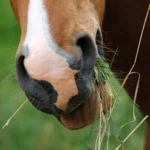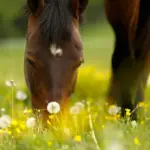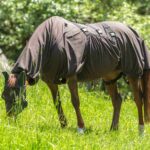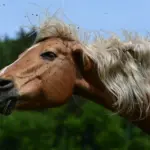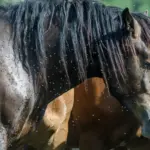The idea of precisely adjusting mineral supplementation to match the roughage is something you hear quite often—and at first, it sounds perfectly logical. However, biological systems are a bit more complex. It starts with the fact that you can’t determine exactly how much of which minerals the horse actually absorbs from the roughage. Of course, you can have samples analysed from every bale of hay.
The plants in hay meadows are not evenly distributed
If the hay doesn’t come from a monoculture field but is instead a species-rich, horse-friendly hay, you can already observe when looking at such meadows that the plants are not evenly distributed across the field.
Herbs and grasses tend to form distinct “patches” where they grow in clusters. The larger the meadow, the more variation there is in vegetation across different areas. Even a gentle slope is enough for different plants to thrive on the south side of a small hill compared to the north side. A slight dip in the terrain can cause rainwater to collect and linger, and during dry periods, moisture tends to remain there longer. As a result, this dip will also support different types of vegetation.

During harvesting, the plants from the area are not evenly mixed together, but rather, the plants from a specific section tend to stay relatively close together when the hay is baled. This means that hay bales from such fields often contain corresponding clusters of plants, forming distinct pockets or patches. All you have to do is roll out an entire round bale along a long barn aisle and walk along this strip. Depending on which part of the bale the sample was taken from, you can get very different mineral values.
Of course, one could argue that hay analyses should always involve taking multiple samples from a single bale (from the outside and inside) as well as samples from several different bales, which are then pooled into a composite sample. While this does provide an approximate average value for the meadow, it doesn’t reflect what and how the horses actually eat the hay. After all, when feeding hay, I don’t mix different layers from various bales into one hay net (like a pooled sample); instead, I usually feed one bale more or less from start to finish before opening the next one.
So, from one feeding to the next, the mineral content in the hay the horses eat can vary significantly.
If I also have hay from different meadows and with different cutting times, then I need to take a pooled sample from each batch (batch = one cut from the same meadow; the second cut from the same meadow counts as a new batch) to determine its mineral content. That’s because mineral levels can vary greatly from one meadow to another, as well as from cut to cut and from year to year. The first cut of a meadow this year can have completely different mineral levels than a cut from the same meadow at the same time last year.
Stabled horses
On top of that, the amount of hay horses eat can vary greatly. When a horse is kept exclusively in a stable, it’s still fairly easy to track how much hay the horse consumes. I simply need to weigh the amount of hay I offer as feed and then weigh the leftovers I remove from the stable. Of course, it’s important to ensure that any damp hay removed—such as hay the horse has urinated on—is dried before weighing, down to a residual moisture content of 10–15%, so the measurement isn’t distorted. This allows me to get a fairly accurate estimate of how much the horse actually consumed, assuming it’s kept on bedding that isn’t edible. If the horse is bedded on straw, things become more difficult, as it’s nearly impossible to determine how much straw the horse may have eaten along with the hay. In addition, in such cases, it’s hard to say how available the minerals in the straw actually are—despite being measurable in a chemical analysis—because straw is highly lignified. This means that, unlike the plant cells in hay, the cells in straw cannot be efficiently broken down by the horse’s large intestine.
You would therefore need an analysis value for the mineral content present in the phloem and xylem—the plant’s transport system—which is relatively easily accessible to horses, and subtract the portion that is locked within the cells. Unfortunately, this type of analysis is not technically possible, which makes it quite difficult to determine the exact amount of minerals the horse actually absorbed.

Keeping horses in an open stable or group housing system
Determining the amount of hay actually consumed by each horse in an open stable (group housing system) is also challenging. While you can weigh out a specific amount per horse and place it in the feeder, there’s no way to know whether the individual horse actually ate that amount. Horses have very different eating speeds, and some can eat up to four times faster than others. So, if there’s a particularly greedy horse in the group, it’s likely to have eaten significantly more hay than its calculated share—leaving less for the others.
The same applies to grazing: horses don’t eat the plants evenly like a lawnmower—they are selective grazers. So even if I send in samples of my pasture for analysis, it doesn’t necessarily mean the horse actually ate the plants included in that sample. Additionally, it’s impossible to precisely determine how much grass a horse consumes during grazing, as the amounts can vary greatly. Here too, a horse can increase its eating speed by up to four times. And in terms of analysis data, there’s a big difference between a horse consuming 10 kg or 40 kg of fresh pasture grass. Without an accurate measurement of the roughage actually eaten, I can’t reliably determine how much of which mineral the horse has absorbed—no matter how detailed the analysis results may be.

It becomes clear that the theory of tailoring mineral supplements precisely to the mineral content of the forage, unfortunately, does not work in practice when aiming for species-appropriate horse management.
The horse has the ability to store minerals
The good news is that, over the course of around 50 million years of evolution, the horse has adapted to fluctuating mineral levels in its roughage.
The horse’s body has storage capacity for all essential minerals. For example, bones serve as a major reservoir for calcium, muscles contain surplus phosphorus, and the liver can temporarily store zinc, copper, and iron. If the feed contains sufficient amounts of a mineral, the horse absorbs it and stores it in the body. When the herd moves on and the forage in the new area is low in that mineral, the body can draw from these stores to keep the metabolism running smoothly. As soon as the forage once again contains higher levels of that mineral, the body’s stores are replenished. In addition, the horse’s intestinal wall has a “sorting mechanism” for minerals. Minerals don’t just pass randomly from the gut into the body—that would be disastrous. Instead, their absorption is a highly regulated process involving mineral receptors and transporter molecules within the cells of the intestinal wall. This process is controlled by the nervous and hormonal systems.
For example, calcium is almost always present in the horse’s forage in massive excess—both in relation to the horse’s actual needs and to phosphorus (which is regulated in relation to calcium). As a result, not all the calcium from the feed is absorbed; a large portion remains in the digestive tract and is excreted in the manure. Excess minerals that are absorbed but not needed can also be excreted again. The kidneys play a central role here, as they regulate the mineral balance by eliminating surplus minerals. This is why horse urine is typically cloudy—it contains excess calcium excreted in the form of calcium carbonate. In contrast, this doesn’t occur in carnivores, as calcium tends to be relatively deficient compared to phosphorus in their diet. As a result, they are more likely to excrete phosphorus, and their urine is clear. The balance between intake, storage, and excretion of calcium and phosphorus is regulated in part by parathyroid hormone and calcitonin, working together with vitamin D3. In horses, vitamin D3 is either produced in the skin through sunlight exposure or converted from its precursor, vitamin D2, found in forage—particularly important when sunlight is insufficient. The details of this well-studied physiological process can be found in any standard physiology textbook. These regulatory mechanisms exist for all minerals: Their absorption is controlled, they are stored in the body to be available during times of deficiency, and—apart from selenocysteine—they can generally be excreted without issue. Only in cases of extreme oversupply (such as iodine from seaweed when it’s used as the sole mineral source, or selenium in the Great Plains of the USA, where selenium-accumulating plants concentrate this trace element) or with the use of organic mineral compounds that are rare in nature, can these natural regulatory systems be overridden. This can lead to oversupply or even toxicity. For good reason, feed legislation sets maximum allowable levels for many minerals in animal feeds to prevent such risks.
Feeding minerals based solely on the requirement values listed in feeding manuals is largely pointless.
First, you’d have to subtract the amount already supplied by the forage from the stated requirement value—along with all the challenges that come with that, as explained above. Second, the requirement values printed in feeding manuals are typically based on studies conducted with Thoroughbreds or sport Warmbloods. This is simply because a reliable statistical analysis requires a large number of horses of the same breed, ideally all receiving the same type of feed and training. Thoroughbreds and sport horses are ideal for such studies. In contrast, a mixed open-stable group with individualized feeding routines doesn’t provide a standardized enough basis for meaningful statistical analysis. However, we now know from other studies that Thoroughbreds and Warmbloods have a metabolism that functions quite differently in many respects compared to ponies and hardy/native breeds. Moreover, especially in the case of Thoroughbreds and Warmbloods, their feeding is often far from what would be considered species-appropriate—typically involving too little hay fed in meals with long gaps in between, along with large amounts of concentrate feed. Their workload—and thus their mineral requirements—is also significantly higher than that of leisure horses. For some time now, experts have been discussing the fact that the daily requirement values found in the literature are likely set far too high for the majority of horses. For some time now, experts have been discussing the fact that the daily requirement values found in the literature are likely set far too high for the majority of horses. But where exactly those values should be—for my actively ridden Icelandic horse, the Gypsy Cob strolling through the countryside, or the laminitis-prone Welsh D —nobody really knows.

Determining such values is further complicated by the body’s ability to buffer deficiencies over long periods through its storage mechanisms. In other words: a horse is more likely to suffer bone fractures due to demineralisation long before a calcium deficiency would ever show up in a blood test. Additionally, it’s not possible to feed horses a mineral-free diet. Hay and grass typically contain so much iron that it’s virtually impossible to induce an iron deficiency—especially since iron is extensively recycled by the liver from hemoglobin. The only real exceptions would be if a horse were to lose several liters of blood or suffer from a massive worm infestation. But those are hardly natural conditions. There are also minerals—selenium being a well-known example—where experts have long acknowledged that blood levels show little to no correlation with the actual levels present in body tissues. Other minerals, such as sulfur, can’t be detected in the blood at all because they only occur in bound form. So even with the most detailed blood panel, we can’t reliably detect a deficiency in most minerals in time to counteract it through targeted supplementation. Only copper and zinc provide some degree of insight in a blood test. However, if their levels are low, this could indicate either an insufficient intake or an increased demand—for example, due to impaired detoxification processes. So, as we can see: in theory, tailoring mineral supplementation to a horse’s exact needs is a good idea—but in the reality of biological systems, it simply doesn’t work.

When it comes to feeding mineral supplements, this means taking a practical approach: what matters is not the exact number of milligrams of each mineral, or whether the calcium-to-phosphorus ratio is 2:1 or 4:1. These are details the horse’s body can regulate on its own, depending on the mineral content already provided through the forage. What truly matters is that mineral supplements are offered regularly and in cycles, so the horse has the chance to replenish its mineral stores whenever they begin to run low. Minerals for which the body’s stores are still well stocked remain in the digestive tract and are excreted with the manure or eliminated via the urine. This allows the horse to compensate for fluctuations in the forage—fluctuations that aren’t always visible in hay or grass. For example, many hay samples show copper deficiencies, as a plant’s copper uptake depends not only on the plant species but also on the molybdenum content of the soil. When copper stores run low, they need to be replenished—this is where a mineral supplement that includes copper, along with other essential minerals, plays a key role. For this reason, offering minerals via mineral lick blocks (provided they aren’t made from sugary carrier substances) works just as well as providing them through standard mineral feeds—as long as those feeds aren’t overly sweetened or designed primarily for palatability.
- Assessing the correct body condition in horses - 21. June 2025
- Sugar levels in grass – when do they become a problem? - 19. June 2025
- Choosing the Right Fly Sheet: The Ultimate Guide for Horse Owners - 13. June 2025






